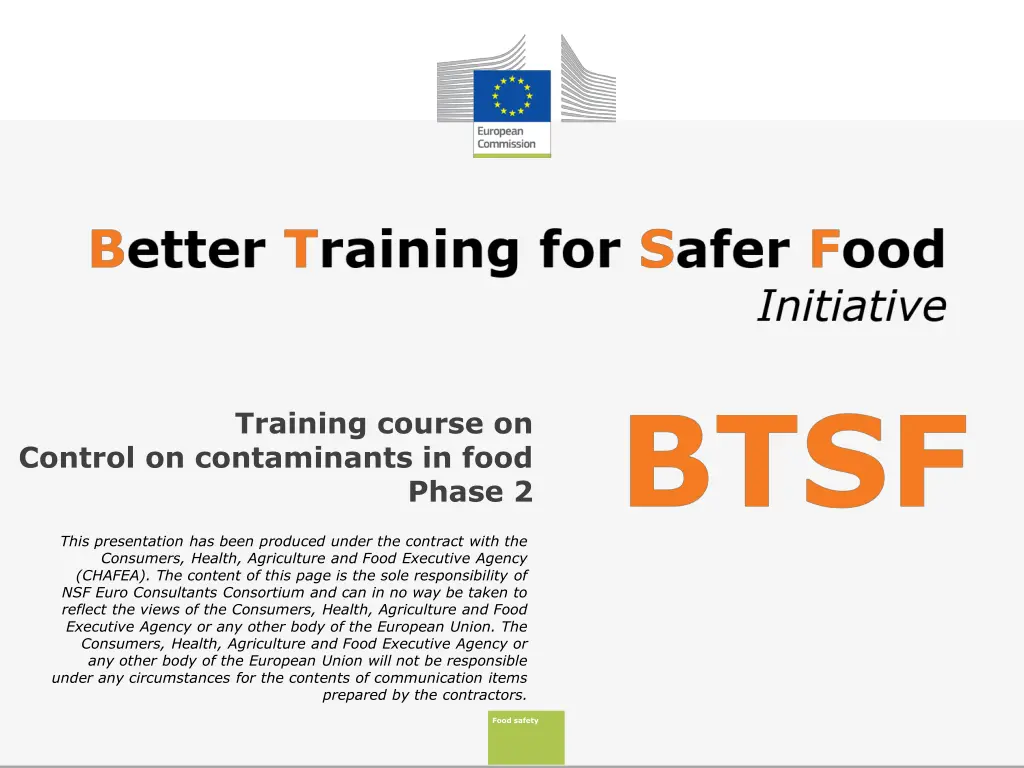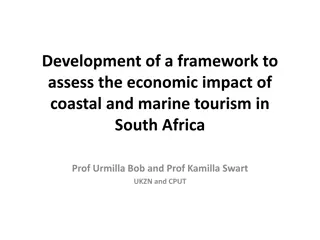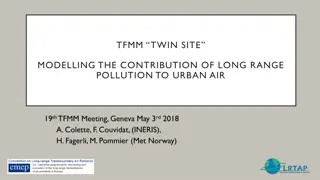
Control of Contaminants in Food: Risk Assessment and Management
Learn about risk assessment and management in the context of controlling contaminants in food. Explore topics such as hazard identification, exposure assessment, establishment of tolerable daily intake, and calculation of safety factors.
Download Presentation

Please find below an Image/Link to download the presentation.
The content on the website is provided AS IS for your information and personal use only. It may not be sold, licensed, or shared on other websites without obtaining consent from the author. If you encounter any issues during the download, it is possible that the publisher has removed the file from their server.
You are allowed to download the files provided on this website for personal or commercial use, subject to the condition that they are used lawfully. All files are the property of their respective owners.
The content on the website is provided AS IS for your information and personal use only. It may not be sold, licensed, or shared on other websites without obtaining consent from the author.
E N D
Presentation Transcript
Training course on Control on contaminants in food Phase 2 This presentation has been produced under the contract with the Consumers, Health, Agriculture and Food Executive Agency (CHAFEA). The content of this page is the sole responsibility of NSF Euro Consultants Consortium and can in no way be taken to reflect the views of the Consumers, Health, Agriculture and Food Executive Agency or any other body of the European Union. The Consumers, Health, Agriculture and Food Executive Agency or any other body of the European Union will not be responsible under any circumstances for the contents of communication items prepared by the contractors. Food safety
1.2 Risk assessment and risk management in the risk analysis cycle & 1.3 Reminders on risk management measures at EU level 1 Mrs. Isabelle Oswald Food safety
The risk analysis framework Risk Management Risk Assessment Asses policies alternatives Select and implement appropriate options Hazard identification Hazard characterization Exposure assessment Risk characterization Risk Communication Interactive exchanges of information and opinions Official journal of the European Union 2 EFSA Journal Food safety
Risk assessment Hazard identification Exposure Assessment Hazard characterization Establishment of a TDI Risk characterization 3 Food safety
Establishment of tolerable daily intake Databases are evaluated for substances for which a threshold exist Critical effects are identified NOAELs are identified in each study Relevance to humans is determined, if possible In the absence of other information, the lowest NOAEL is used for the basis of the TDI A safety factor is applied to the NOAEL when establishing a TDI (default: 100). 4 Food safety
Calculation of the safety factor This is a factor by which the NOAEL will be multiply to the data obtained in animal to get a value for humans. A factor 10 to take into consideration the inter-individual variability A factor 10 to take into consideration the inter-species variability (human is considerer to be 10 times more susceptible than the most susceptible species) A factor 1 to 50 to take into account, when they are demonstrated, the irreversible effects such as cancerogenic or mutagenic effect 5 Food safety
Dose response data and determination of the tolerable daily intake 6 Food safety
Derivation of a health based guidance value for erucic acid in humans Overall NOAELfor lipidosis of 0.7 g/kg bw per day, observed in a 7-day feeding study in young rats and in a 2- week feeding study in newborn piglets, as reference point for the risk assessment. A TDIof 7 mg/kg bw for erucic acid using the default uncertainty factor of 100 to account for intra- and inter- species differences. No additional uncertainty factor was applied to extrapolate from the short-term to long-term duration of the exposure because lipidosis is transient and reversible. 7 EFSA Journal 2016;14(11):4593 Food safety
Derivation of a health based guidance value for erucic acid in animals Pig: NOAEL of 700 mg/kg bw per day for myocardial lipidosis in newborn piglets. Poultry: a LOAEL of 20 mg/kg bw per day for liver toxicity. The available database on adverse effects in ruminants too limited to identify an overall NOAEL. No NOAEL/LOAEL could be identified for horses, fish and rabbits. NO SAFETY FACTOR 8 EFSA Journal 2016;14(11):4593 Food safety
Benchmark dose (BMD) analysis: a new concept Used for both non-thresholded and thresholded compounds Based on modeling of the experimental data Determination of a Benchmark Response (BMR) Benchmark dose (BMD) and a BMDL10: 95% lower confidence limit of the BMD for 10% extra risk of critical effect 9 Food safety
Benchmark dose (BMD) analysis: example of the T2 toxin T2 toxin: 90 days subchronic toxicity study with rats, dose dependent reduction in total leucocyte count. BMR of 10%, response in leucocyte counts within the individual physiological variation. A 95% lower confidence limit for the benchmark dose response, BMDL10= 3.3 g T2/kg bw. Uncertainty Factor of 200: 10 for interspecies, 10 for intraspecies variation and 2 subchronic study (and the toxic effect progressed during the whole study period reaching no plateau at the end of the study). TDI of 0.02 g T2 or HT2/kg bw per day (rounded from 0.017) . EFSA Panel on Contaminants in the Food Chain. EFSA Journal 2017;15(1):4655 10 Food safety
Benchmark dose (BMD) analysis: example of the T2 toxin EFSA Panel on Contaminants in the Food Chain. EFSA Journal 2017;15(1):4655 11 Food safety
Risk assessment Hazard identification Exposure Assessment Hazard characterization Establishment of a TDI Risk characterization 12 Food safety
Exposure assessment Analytical data on the concentration of the chemical contaminant in the food Food chemical Consumption Food chemical concentration Concentration Consumption * Dietary exposure Dietary exposure = = Body weight Data on the consumption level of the different food mg or g / kg bw / day 13 Food safety
Risk assessment Hazard identification Exposure Assessment Hazard characterization Establishment of a TDI Risk characterization 14 Food safety
Risk characterisation Exposure < TDI No risk for the consumer (human or animal) Exposure > TDI Risk for the consumer (human or animal) 15 Food safety
The case of genotoxic/carcinogenic compounds JEFCA advised that they be present in the food at irreducible levels (concentration of a substance of which cannot be eliminated from a food without involving the discard of that food altogether, or severely compromising the ultimate availability of major food supplies) Other organization often refer to this as ALARA (As Low As Reasonably Achievable) Nevertheless it is important to evaluate/classify these contaminant. Determination of the Margin of Exposure (MoE) 16 Food safety
Margin of Exposure (MOE): definition Tool to consider possible safety concerns arising from the presence in food and feed of substances which are both genotoxic (they may damage DNA) and carcinogenic. The MOE is a ratio of two factors which assess for a given population the dose at which a small but measurable adverse effect is first observed and the level of exposure to the substance considered. 17 Food safety
Margin of Exposure (MOE) MOE < 10 000 of concern MOE > 10 000 of low concern 18 Food safety
New approaches Insufficient toxicological record Impossible to determine a TDI How to characterize the risk without characterizing the danger? NEW APPROACHES ARE NEEDED 19 Food safety
New approaches Margin of Safety Threshold of Toxicological Concern Read Across Weight of Evidence Mode of Action 20 Food safety
Margin of Safety (MoS) Non-genotoxic compound Toxicological data Partial Quality Low exposure, and comparison between: Lowest No effect dose Exposure If MOS > 100 No risk for the consumer Example: Smoke flavourings Primary Products. EFSA Journal 2010, 8:1325. 21 Food safety
Threshold of Toxicological Concern (TTC): definition Qualitatively assesses the risk of low-level substances in the diet. Can be used for an initial assessment of a substance to determine whether a comprehensive risk assessment is required. Context: increasing numbers of substances present at low and very low concentrations in food and feed are now detectable due to improved analytical methods. However, for many such substances there are little or no toxicological data available. 22 Food safety
Threshold of Toxicological Concern (TTC) Class I contains substances of simple chemical structure with known metabolic pathways and innocuous end products which suggest a low order of oral toxicity. Class II contains substances that are intermediate. They possess structures that are less innocuous than those in Class 1 but they do not contain structural features that are suggestive of toxicity like those in Class 3. Class III contains substances with a chemical structures that permit no strong initial impression of safety and may even suggest a significant toxicity 23 Food safety
Threshold of Toxicological Concern (TTC) Type of TTC value TTC value in g/person/day TTC value in g/kg bw per day With structural alert for genotoxicity 0.15 0.0025 OPs and carbamates 18 0.3 Cramer Class III (OTA, ETU ) Cramer Class II (DEHP, BBP ) Cramer Class I (methanol, sodium selenite ) 90 1.5 540 9.0 1800 30 24 Kroes et al. 2004 Food Chem Toxicol EFSA supporting publication 2016: EN-1006 Food safety
Read across: definition Endpoint information for one chemical (the source chemical) is used to predict the same endpoint for another chemical (the target chemical), which is considered to be "similar" in some way (usually on the basis of structural similarity). Read-across can be used to assess physicochemical properties, toxicity, environmental ecotoxicity. fate and Informatic tools exist to group the compound and to read across (Toxmatch, OCDE QSAR) 25 Food safety
Read across: example Safety of calcium L-ascorbate with a content of threonate produced by a new production process and resulting in the by- product 4-hydroxy-5-methyl-3(2H)-furanone (4-HMF) Source chemical: 4-hydroxy-2,5-dimethylfuran-3(2H)-one (HDMF) 2 year carcinogenicity study NOAEL 200 mg/kg bw/day. Target chemical: 4-hydroxy-5-methyl-3(2H)-furanone (4-HMF) 26 EFSA Journal 2011;9(9):2395. Food safety
Conclusion: New challenges in risk assessment of food contaminants Analysis of low dose effects, especially in non- monotonic effect curves Toxicity of mixtures of different food contaminants 27 Food safety
Low dose effects Non-monotonic effect curves What is a low dose dose below the no effect dose dose below the TDI Relation with the dose of human exposure Systemic exposure dose? Tissue concentration? 28 Food safety
Toxicity of mixtures Toxicological equivalent factor (TEF) Additive effect (dioxin, mycotoxins and their modified forms) Synergistic effect Antagonistic effect Pandora box Very expensive In vitro toxicology 29 Food safety
30 Group health-based guidance value for zearalenone and its modified forms -ZEL -ZEL14Glc other -ZELGlcs -ZELSulfs cis- -ZEL cis- -ZELGlcs cis- -ZELSulfs 60 ZEN14Glc ZEN16Glc ZEN14 Sulf cis-ZEN cis-ZENGlcs cis-ZENSulfs cis- -ZEL cis- -ZELGlcs cis- -ZELSulfs 8 -ZAL -ZAL -ZALGlcs -ZALSulfs 4 ZAN ZANGlcs ZANSulfs -ZEL -ZEL14Glc other -ZELGlcs -ZELSulfs 2 1.5 1 0,2 ZEN EFSA Panel on Contaminants in the Food Chain. EFSA Journal 2016;14(4):4425. 30 Food safety
This presentation has been produced under the contract with the Consumers, Health, Agriculture and Food Executive Agency (CHAFEA). The content of this page is the sole responsibility of NSF Euro Consultants Consortium and can in no way be taken to reflect the views of the Consumers, Health, Agriculture and Food Executive Agency or any other body of the European Union. The Consumers, Health, Agriculture and Food Executive Agency or any other body of the European Union will not be responsible under any circumstances for the contents of communication items prepared by the contractors. NSF Euro Consultants Consortium Thank you for your attention! Any questions? Avenue Pasteur,21 1300 Wavre Belgium +32 10 84 97 95 2016.96.05@euroconsultants.be Better Training for Safer Food BTSF European Commission Consumers, Health, Agriculture and Food Executive Agency DRB A3/042 L-2920 Luxembourg Food safety


